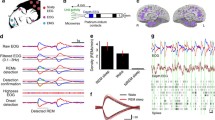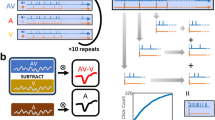Abstract
K-complexes are the EEG elements recorded during the state of developing sleep and during slow wave sleep. They are the only EEG components which can be elicited by sensory stimulation during sleep. The peculiarity of New Zealand rabbits to sleep with their eyes open allows the use of visual stimuli to elicit K-complexes. Experiments were performed with three rabbits. For visual stimulation, an elongated screen illuminated by LED flashes was attached to an implant on the animal’s skull. The screen covered 20–120° of the visual field of one eye, and moved with the head during animal motion. One-millisecond flashes (15-s interval) were used during daytime in an illuminated room. Flashes elicited evoked responses, which, during the first stages of sleep, were often accompanied by K-complexes. The induced K-complexes were recorded from electrodes located both above visual and somatosensory areas. Evoked responses to visual stimuli were also recorded from both pairs of electrodes, although they were generated exclusively in the visual cortex. Correlation analysis showed that visual evoked responses and K-complexes induced by this stimulation were generated in visual cortex, and passively spread to the electrodes above the somatosensory area. Investigation of the latencies of induced K-complexes revealed two time windows when these complexes could be seen. Within each window there was no correlation between latency and amplitude of K-complexes. There was also no correlation between amplitudes of the visual evoked responses and K-complexes elicited by these responses. We propose that visual stimulation in light sleep temporarily opens a gate for some independent external signals, which evoke activation of the visual cortex, reflected in K-complexes.







Similar content being viewed by others
References
Ackner B, Pampiglione G (1957) Some relationships between peripheral vasomotor and EEG changes. J Neurol Neurosurg Psychiatr 20:58–64
Amzica F, Steriade M (1997) The K-complex: its slow (<1-Hz) rhythmicity and relation to delta waves. Neurology 49:952–959
Amzica F, Steriade M (1998) Cellular substrate and laminar profile of sleep K-complex. Neuroscience 82:671–686
Amzica F, Steriade M (2002) The functional significance of K-complexes. Sleep Med Rev 6:139–149
Cash SS, Halgren E, Dehghani N, Rossetti AO, Thesen T, Wang C, Devinsky O, Kuzniecky R, Doyle W, Madsen JR, Bromfield E, Eröss L, Halász P, Karmos G, Csercsa R, Wittner L, Ulbert I (2009) The human K-complex represents an isolated cortical down-state. Science 324:1084–1087
Colrain IM (2005) The K-complex: a 7-decade history. Sleep 28:255–273
Colrain IM, Webster KE, Hirst G (1999) The N550 component of the evoked K-complex: a modality non-specific response? J Sleep Res 8:273–280
Cote KA, de Lugt DR, Langley SD, Campbell KB (1999) Scalp topography of the auditory evoked K-complexes in stage 2 and slow wave sleep. J Sleep Res 8:263–272
Dang-Vu T, Schabus M, Boly M, Bonjean M, Darsaud A, Desseilles M, Phillips C, Maquet P (2008) Processing of sounds during sleep spindles in humans: an EEG/fMRI study of auditory stimulation in non-REM sleep. J Sleep Res 17(S1):O105
Davis H, Davis PA, Loomis AL, Harvey EN, Hobart G (1939) Human brain potentials during the onset of sleep. J Neurophysiol 1:24–38
Engert F, Bonhoeffer T (1997) Synapse specificity of long-term potentiation breaks down at short distances. Nature 388:279–284
Gora G, Colrain IM, Trinder J (2001) The investigation of K-complexes and vertex sharp wave activity in response to mid-inspiratory occlusions and complete obstructions to breathing during NREM sleep. Sleep 24:81–89
Halász PO (2005) K-complex, a reactive EEG graphoelement of NREM sleep: an old chap in a new garment. Sleep Med Rev 9:391–412
Halász P, Pál I, Rajna P (1985) K-complex formation of the EEG in sleep. A survey and new examinations. Acta Physiol Hung 65:3–35
Heald S, Siebers RW, Maling TJ (1989) K-complex vasoconstrictor response: evidence for central vasomotor downregulation in borderline hypertension. J Hypertens Suppl 7:S28–S29
Hill S, Tononi G (2005) Modeling sleep and wakefulness in the thalamocortical system. J Neurophysiol 93:1671–1698
Hornyak M, Cejnar M, Elam M, Matousek M, Wallin BG (1991) Sympathetic muscle nerve activity during sleep in man. Brain 114:1281–1295
Johnson LC, Karpan WE (1968) Autonomic correlates of the spontaneous K-complex. Psychophysiology 4:444–452
Logothetis NK, Augath M, Murayama Y, Rauch A, Sultan F, Goense J, Oeltermann A, Merkle H (2010) The effects of electrical microstimulation on cortical signal propagation. Nat Neurosci 13:1283–1291
Loomis AL, Harvey N, Hobart G (1938) Distribution of disturbance patterns in the human electroencephalogram, with special reference to sleep. J Neurophysiol 13(Suppl):231–256
Lucchetti C, Lanzilotto M, Bon L (2008) Auditory-motor and cognitive aspects in area 8B of macaque monkey’s frontal cortex: a premotor ear–eye field (PEEF). Exp Brain Res 186:131–141
Massimini M, Ferrarelli F, Esser SK, Riedner BA, Huber R, Murphy M, Peterson MJ, Tononi G (2007) Triggering sleep slow waves by transcranial magnetic stimulation. PNAS 104:8496–8501
McMahon LL, Kauer JA (1997) Hippocampal interneurons express a novel form of synaptic plasticity. Neuron 18:295–305
Monstad P, Guilleminault C (1999) Cardiovascular changes associated with spontaneous and evoked K-complexes. Neurosci Lett 263:211–213
Niiyama Y, Sato N, Katsuzava O, Hishikawa Y (1996) Electrophysiological evidence suggesting that sensory stimuli of unknown origin induced spontaneous K-complexes. Electroencephalogr Clin Neurophysiol 98:394–400
Noll G, Elam M, Kunimoto M, Karisson T, Wallin BG (1994) Skin sympathetic nerve activity and effector function during sleep in humans. Acta Physiol Scand 151:319–329
Numminen J, Mäkelä JP, Hari R (1996) Distribution and sources of magnetoencephalographic K-complexes. Electroencephalogr Clin Neurophysiol 99:544–555
Okada H, Iwase S, Mano T, Sugiyama Y, Watanabe T (1991) Changes in muscle sympathetic nerve activity during sleep in humans. Neurology 411:1961–1966
Pampiglione G, Ackner B (1958) The effects of repeated stimuli upon EEG and vasomotor activity during sleep in man. Brain 81:64–74
Pigarev IN (1994) Neurons of visual cortex respond to visceral stimulation during slow wave sleep. Neuroscience 62:1237–1243
Pigarev IN (2005) Brain and sleep. Sci Russ 1:61–65
Pigarev IN, Bagaev VA (2002) Slow waves in EEG and bursty firing of cortical neurons during sleep reflect the peristaltic activity of gastro-intestinal system. J Sleep Res 11:S177–S178
Pigarev IN, Nothdurft HC, Kastner S (1997) Evidence for asynchronous development of sleep in cortical areas. Neuroreport 8:2557–2560
Pigarev IN, Bagaev VA, Busygina II, Fedorov GO, Levichkina EV (2004) Causal link between myoelectrical intestinal activity and cortical neuronal firing in sleep. J Sleep Res 13:575
Pigarev IN, Almirall H, Fedorov G, Marimon J, Pigareva ML (2006a) Visually triggered K-complexes. Study in New Zealand rabbits. J Sleep Res 15:S105
Pigarev IN, Almirall H, Pigareva ML, Bautista V, Sánchez-Bahillo A, Barcia C, Herrero TM (2006b) Visceral signals reach visual cortex during slow wave sleep. Study in monkeys. Acta Neurobiol Exp 66:69–73
Pitijk NI (1973) Reactions of LGB neurons of the cat to visceral and somatic stimulations. Neurophysiologia (Kiev) 5:246–252
Pitijk NI (1977) Participation of visceral afferent excitation in the processes of sensory integration on the neurons of cat’s visual cortex. Neurophysiologia (Kiev) 9:361–367
Roth M, Shaw J, Green J (1956) The form, voltage distribution and physiological significance of the K-complex. Electroencephalogr Clin Neurophysiol 8:385–402
Shimizu T, Takahashi Y, Suzuki K, Kogawa S, Tashiro T, Takahasi K, Hishikawa Y (1992) Muscle nerve sympathetic activity during sleep and its change with arousal response. J Sleep Res 1:178–185
Takigawa M, Uchida T, Matsumoto K (1980) Correlation between occurence of spontaneous K-complex and the two physiological rhythms of cardiac and respiratory cycles. No To Shinkei 32:127–133
Tank J, Diedrich A, Hale N, Niaz FE, Furlan R, Robertson RM, Mosqueda-Garcia R (2003) Relationship between blood pressure, sleep K-complexes, and muscle sympathetic nerve activity in humans. Am J Physiol Regul Integr Comp Physiol 285:R208–R214
Vyazovskiy VV, Faraguna U, Cirelli C, Tononi G (2009) Triggering slow waves during NREM sleep in the rat by intracortical electrical stimulation: effects of sleep/wake history and background activity. J Neurophysiol 101:1921–1931
Zimmermann M (1987) Ethical principles for maintenance and use of animals in neuroscience research. Neurosci Lett 73:1
Acknowledgments
We are obliged to Dr. Leon Voronin for his suggestions concerning the neurophysiological mechanisms for the effects found in this study. We are very thankful to Drs. Denys Garden and Yuri Saalmann for their critical reading of the manuscript. This work was supported by The Russian Foundation for Basic Researches Grants N 07-04-01486, 10-04-00844 and by the Research program of the Division of the biological sciences RAS.
Author information
Authors and Affiliations
Corresponding author
Rights and permissions
About this article
Cite this article
Pigarev, I.N., Fedorov, G.O., Levichkina, E.V. et al. Visually triggered K-complexes: a study in New Zealand rabbits. Exp Brain Res 210, 131–142 (2011). https://doi.org/10.1007/s00221-011-2606-2
Received:
Accepted:
Published:
Issue Date:
DOI: https://doi.org/10.1007/s00221-011-2606-2




